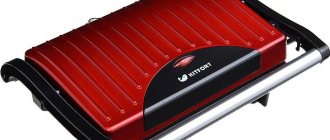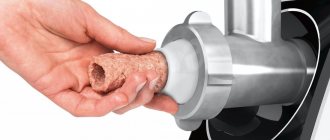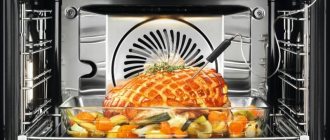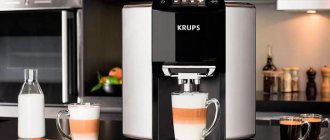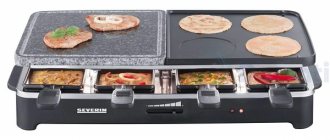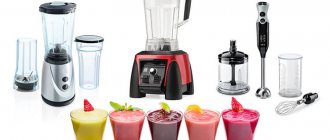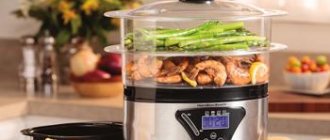How many household appliances do you need for comfortable and quick cooking? A meat grinder, juicer, mixer, and coffee grinder are indispensable in the kitchen. Due to the lack of storage space for all these appliances, many people refuse modern devices that save time and make kitchen work easier.
Several pieces of equipment combine multifunctional harvesters, but they do not take up much less space and do not fit into every budget. Those who want to cook easier and faster should pay attention to a kitchen blender. Let's figure out what a blender is for, what they are and how they differ from each other.
What is a blender and who invented it?
The word blender comes from the English blender - to mix. This unit is one of the oldest kitchen units. Only the meat grinder is older than him (25 years).
The first such device was invented by Stephen Poplawski in 1922. The idea for this device came to him in an attempt to automate the preparation of the soda fountain drink. In the USSR, such a drink was known as “soda with syrup,” which was sold everywhere in special vending machines.
The first of these units consisted of a container on a stand. At the bottom of the bowl there was a knife similar to a propeller, which could only mix the ingredients, but not cut. In fact, this was the first prototype of a stationary blender.
It became widespread during Prohibition in the United States due to the fact that establishments began to secretly serve alcohol only in cocktails (to avoid police claims). The blender at that time allowed bartenders to automate the preparation of drinks and meet the increased demand.
A modern blender can easily replace a food processor. Its main advantage is that it is quite small-sized and easy to handle, which allows it to be used without any extra effort. With this unit you can easily chop, cut and beat ingredients for dishes.
About
History of creation
The inventor of the first blender is Stephen Poplawski, an American-born inventor. This happened in 1922.
He created the device to mix carbon dioxide, syrup and water to produce carbonation. Poplawski's compatriot Fred Osius improved the idea in 1937 and proposed a new version of this device that could crush food.
Swiss Roger Perinjaque created a hand-held version of the blender in 1950, which has become a must-have piece of equipment in the kitchens of professional chefs. It was then that the new household appliance began to become widespread throughout the world.
Types of devices and their differences
Existing types of blenders:
- submersible;
- stationary.
A stationary blender is a device that consists of a technical unit and a mixing glass with knives at the bottom.
The advantage of this type of device is that, unlike an immersion blender, you do not need to constantly hold the device in your hands to grind food.
The disadvantage of a stationary blender is that you can only mix the ingredients in the bowl supplied. But it is great for making various cocktails and smoothies.
An immersion blender differs from a stationary blender in having wider functionality. The device consists of two parts: a hardware unit and an attachment, while the number and functionality of attachments may vary.
Pros of an immersion blender:
- You can grind products in any container that is resistant to mechanical stress, which allows you to work with any volume of ingredients
- A large number of attachments that expand functionality (whisk, chopper, etc.)
- It doesn't take up much space in the kitchen
Flaws:
- You must always hold the device in your hands
- Not suitable for preparing liquid foods
Blender bowls and containers can be made of plastic, glass and metal. At the same time, glass, if handled carefully, is the most durable and environmentally friendly. Nozzles are made of stainless steel or plastic.
Professional blenders are a special type of device. They have large bowl capacity, power and high reliability, but their price is much higher. Also, as you can already understand from the name, such devices can be not only for home use, but also for commercial use.
As a result, the difference between devices for grinding products lies in their different purposes. The stationary one is better at mixing and whipping liquid mixtures, and the submersible one is better at slicing and grinding harder products.
About
Recommendations for purchasing a device
When choosing a device, it is important not only to know what a blender of a particular modification is intended for, but also to pay attention to the details. The following can play a role in making a decision in favor of a particular model :
- Power. This value determines what can be ground in a blender. The device can easily process soft food with a power rating of up to 500 W. For solid ingredients, a more powerful model will be required.
- Speed. Affects the processing time of products. Smoothly adjustable with a rotary knob or a choice of fixed levels. Simplified models do not have a speed controller.
- Possibility of battery operation. Such devices are low-power and heavy. It is advisable to use them outside the home or when the work area in the kitchen is far from the outlet. Needs to be charged regularly.
- Availability of additional functions. If you plan to use the device for any other purposes besides shredding, carefully study the attachments included with the device.
- Material and volume of the bowl. Bowls usually have a capacity of up to 2 liters. The set may include additional containers smaller than the main one. They are made from glass or plastic. Glass ones are resistant to high temperatures, but more fragile. Plastic gets scratched over time.
- Material of the immersion part. Metal is more durable and heat-resistant than plastic, but heavier. Plastic devices are slightly inferior to metal ones. They are lighter, but over time they can change color under the influence of coloring agents in products.
- Appearance of the case. The body is also made of metal or plastic. When choosing, it is worth noting whether the body of the device is equipped with rubberized inserts or anti-slip feet, and whether the button on the submersible model is conveniently located.
- Noise produced. Powerful devices are noisier.
Assess your needs before purchasing a blender . Analyze the frequency and volume of food preparation, the range of products that you usually use. The composition of the family is important - the number of people, their age, preferences.
Useful features of blenders
Here are the most popular blender functions:
- Mixing - one of the most popular functions allows you to mix and simultaneously beat liquids and suspensions until smooth. This function is basic for stationary devices.
- Shredding and slicing - allows you to grind food to the required consistency. In some models, the duration and intensity of cutting can be controlled manually, which allows you to achieve the optimal consistency of products for each dish, from slicing to purees.
- Whipping - many hand blenders have this mode thanks to the whisk attachment. In some cases, it allows you to replace the mixer, but it is still inferior in power.
Additional features and capabilities:
- Ice crushing.
- Preparing mixtures in a vacuum environment (allows you to keep cocktails fresh longer).
- Speed adjustment and turbo mode (allows you to control the speed and intensity of the device).
- Grate food directly into the cooking bowl thanks to the grater attachment.
- Expensive models have the function of kneading dough using special hook attachments. Thanks to them, the dough is kneaded evenly and does not stick to the walls of the bowl.
About
Recipes
With this device you can prepare a variety of dishes. There are many delicious recipes using different ingredients.
Soup in a blender
You will need 1.5 liters of chicken broth, dried mushrooms, 500 grams of fresh leeks, 1 onion, 50 grams of green onions. The recipe also contains 200 grams of cream and 500 grams of potatoes.
To begin, place the dried mushrooms in the broth for about an hour. Then put the peeled and diced potatoes into it and put it on the fire. At this time, cut and fry the onion until golden brown, add it to the already boiling water and cook the soup until tender. At the end, add cream and grind the soup with a blender until smooth.
Cream soup with pumpkin
For this dish you need to prepare 1 kilogram of pumpkin, 2 tomatoes, one head of garlic and a liter of broth. Prepare 200 ml low-fat cream, 100 g butter, and one red onion.
To prepare soup puree, you will need to fry the vegetables and add chopped pumpkin to them. All components are prepared in about 20 minutes. 5 minutes before it’s ready, add the broth and wait until it evaporates. Now you can place the soup in an immersion blender, pour in the cream and beat thoroughly.
The dish is served immediately after preparation. Cream makes the consistency more delicate, so choose quality products. You can decorate the soup with fresh herbs and sour cream.
What can you cook in a blender?
Using a blender you can prepare a huge number of dishes:
- puree soups;
- cocktails;
- sauces;
- salads;
- various desserts.
Here are some of the most popular dishes and the general principle of preparing puree soups.
The principle of preparing puree soups using the example of cream of mushroom soup
To prepare mushroom cream soup from champignons, you need:
- 500 grams of potatoes of any size.
- 150 grams of onion.
- 600 grams of water.
- 250 grams of mushrooms (fresh or frozen).
- 200 grams of cream 10-20% fat.
- salt (at your discretion).
First, finely chop the onion into cubes and fry in refined vegetable oil for 5 minutes at medium temperature until golden brown.
Mushrooms are cut into medium pieces (you can cut several pieces lengthwise “in the shape of a mushroom” for decoration). Chopped champignons are added to the fried onions and fried together for 7-10 minutes to enhance the taste and aroma.
Next, place a pan of water on the stove and prepare the potatoes (peeled and cut into the size of a walnut). After boiling, the potatoes are thrown into the water and cooked until tender for about 15 minutes.
Then add the onion-mushroom mixture to the pan and cook for another 5 minutes, and then grind the pieces of vegetables in the soup with a blender until pureed.
The last step is to add cream to the prepared mixture and bring to a boil, stirring. The dish is decorated with pieces of fried mushrooms and herbs.
The general principle for preparing all such soups is to grind the solid ingredients to a homogeneous puree-like mass, and the base of the soup can be anything: vegetable, as in the presented recipe, or broth.
Curd
The recipe for making curd mass is extremely simple.
To make the curd mass, you need:
- about 500 grams of cottage cheese
- 4-5 large spoons of sour cream
- salt and sugar to taste
Proportions are approximate and may vary. Also, if desired, you can add various berries and jam.
An immersion blender works best for preparing this dish. All ingredients are loaded into a bowl and ground until smooth within 2-3 minutes.
Milkshake
A stationary blender will handle a milkshake better.
The principle of its preparation is to whip milk and ice cream with various fillings. Moreover, the ratio of ingredients can be very different depending on preferences. For example, for a classic milkshake, a glass of milk and a couple of scoops of creamy ice cream will be enough.
Of course, this is not everything that can be prepared using a blender; there are hundreds of recipes using this device.
About
Methods of application and areas of use
An immersion blender and a stationary blender are varieties of the same device, but their areas of use and methods of application differ. Some of their functions are similar, but their effectiveness when performing such tasks, for example, preparing pureed soups, is different. To choose the optimal device for your needs, you need to understand the purpose of this technology.
Immersion blender
An immersion blender is equipped with a large number of attachments and for this reason is a more versatile device. It is purchased if you need equipment that can perform many different tasks.
To understand how the device can be used, it is worth understanding the purpose of its attachments, which, depending on the model and configuration, may include:
- Main leg. Used in the measuring cup included in the kit or in any container. It is used to mix sauces, baby food, pureed soups, and cocktails.
- Whisk attachment. Designed for making cream, beating eggs, batter, cream. Some models have nozzles with two whisks.
- Hooks. Designed for kneading dense dough or mixing minced meat with spices and onions.
- Chopper. Bowl with a knife inside. Used for chopping herbs, vegetables, fruits, boiled meat, cheese, chocolate, preparing vegetable puree or pate. Can be equipped with an ice pick.
- Multifunctional bowl with chopping blade and discs for slicing food. It has an increased volume compared to a conventional chopper and is suitable for processing a larger number of products. In addition, it may include grater knives, shredders, and a dicing attachment. Suitable for quick preparation of Olivier-type salads and preparations for the winter.
- Leg for mayonnaise. Used for making mayonnaise and sauces. Compared to other attachments, it is much less common.
- Attachment for mashed potatoes. A regular attachment will not cope with this dish - you will end up with a non-uniform sticky mass with lumps.
Thus, immersion blenders are universal equipment that can replace many other devices and accessories at home. Devices of this type become excellent assistants for young mothers, helping them prepare food for small children. These same devices are effective in the country, where they allow you to prepare vegetables, herbs, as well as berries and fruits for the winter to mix with sugar.
What can you grind in a blender?
You can grind many ingredients in a blender.
The most popular of them are:
- Vegetables, fruits and berries - cucumbers, tomatoes, carrots, cabbage, eggplants, zucchini, onions, pumpkin, apples, bananas, pears, etc. Almost any berries can be chopped. It is important to mention that when mashing boiled potatoes with a blender, it becomes more viscous and dense due to starch and this consistency will not be to everyone’s taste. You should also refrain from blending apples with metal attachments, since when it comes into contact with metal, the apple oxidizes and changes its taste.
- Various greens - parsley, dill, green onions.
- Nuts - peanuts, walnuts, cashews, almonds and others. At the same time, they can be ground into a paste.
- Meat - beef, pork, veal, lamb. The resulting minced meat has a slightly different, denser consistency, which makes the cooked meat more uniform, but less juicy.
- The blender can also be used as a coffee grinder - grind coffee and crush ice if you have a special grinder.
For better processing, it is recommended to pre-cut all products into pieces, and boil especially hard ones.
About
Main purpose of the device
Considering the fact that the blender is one of the oldest kitchen machines, appearing long before the creation of the mixer and food processor, its mixing and chopping functions can be called universal. Thanks to the system of rotating metal knives, the device copes perfectly with hot and cold dishes of liquid and solid consistency.
If you go in order, you can divide the preparation into the following categories:
- drinks - milk, fruit, vegetable or alcohol cocktails, smoothies with pieces of ice;
- mousses and pates - curd mixtures with vegetable additives, including nuts, as well as finely ground meat or fish;
- puree – any soups or main courses that can be ground into a paste;
- liquid dough or egg mixture.
The ability of a blender to turn any food into a soft diet consistency is necessary primarily for children, the elderly if they have dental problems, as well as dieters with diseases of the digestive tract.
Special blenders for preparing baby food have jars included
But the grinding process, which more clearly reveals the taste of products, will also be appreciated by completely healthy users. Sauces, pates and puree soups occupy a worthy place in expensive restaurants. Therefore, a home kitchen assistant will give you the opportunity to create small culinary masterpieces in your own kitchen.
The blender is also an absolute favorite among fans of healthy eating or vegetarians. They prepare healthy blends of plant-based ingredients, including nuts, daily.
The most important rules of use
Basic Rules:
- It is forbidden to wash the base handles and motor stands under running water or immerse them in it in any way, as the liquid will damage the electronic components. To clean these parts, use a well-wrung damp cloth or a special cleaning cloth.
- If a burning smell appears during operation, turn off the device immediately.
- Do not use a faulty device; if it breaks down, take it to a qualified technician at a service center.
- The use of the blender by children and persons who do not have the skills to safely handle the device is prohibited.
- When operating the blender, do not put your fingers into the container with the device running, and also be careful when washing, as the knives are very sharp.
These operating instructions for the device should be treated with extreme caution, as failure to comply may result in injury and damage to the device.
About
What is an immersion blender?
An immersion blender consists of a handle with a motor and control buttons and a long attachment equipped with sharp steel knives. As the name suggests, to work it must be immersed in a container and held in your hand.
This design may seem inconvenient, but thanks to the high rotation speeds of the blades, the blender is able to grind any product in a matter of minutes or even seconds.
What is it needed for?
A high-quality immersion blender combines several devices at once: a chopper, a mixer, and a meat grinder. With its help, you can not only grind products, but also beat them, mix and grind them.
The functionality of the blender can be expanded with various attachments:
- a nozzle with knives is used for chopping and chopping hard ingredients;
- the whisk attachment whips liquid products;
- The hook attachment allows you to knead thick dough.
In addition, some devices have additional functions, for example, an ice crusher, a grinder or a mashed potato masher.
What can you do?
As follows from the above, an immersion blender has extensive functionality.
First of all, you can use an immersion blender to chop food (for example, for salad) and prepare puree. This function will be very useful for families with a small child. You can also prepare fruit or vegetable purees for subsequent preservation and homemade preparations.
The blender will be appreciated by lovers of baking, as it can be used to easily beat eggs, cream or cream. Special attachments will allow you to prepare the dough of the desired consistency and make many sweet desserts.
It should be noted that a blender is indispensable when creating a wide variety of cocktails or smoothies. In general, we can say that the use of a blender is limited only by the owner’s imagination.
General step-by-step instructions
Instructions on how to properly use a stationary blender:
- Connect the block rack with the motor to the electrical network
- Place food in the mixing bowl without exceeding the maximum mark.
- Attach the filled bowl to the motor unit and be sure to cover it with a lid.
- Turn on the device using the required mode, following the time recommended for continuous operation (it varies for devices from different manufacturers, usually 2-3 minutes)
- After mixing, pour the resulting mixture into a container, and carefully wash the bowl and wipe dry
- Unplug the device from the outlet after use.
Instructions for the immersion blender:
- Attach the required attachment to the blender
- Connect the handle-base with the motor to the electrical network
- Place food in a scratch-resistant container
- Turn on the device using the required mode, following the time recommended for continuous operation (it varies for devices from different manufacturers, usually 2-3 minutes)
- When you are finished mixing or grinding, unplug the appliance.
- Detach the nozzle from the base handle for later washing
If you follow the correct operating mode, your blender will remain an indispensable assistant in the kitchen for a long time and will serve for many years.
About
What is a blender for?
A blender is a type of household appliance that replaced the food processor and almost completely replaced it. Like its predecessor, it is needed for making sauces, smoothies, baby food, chopping vegetables, fruits and meat, crushing ice, and performing many other tasks. At the same time, it is more compact and takes up less space during storage and during cooking.
Unlike a food processor, which had to be washed almost completely after use, a blender requires less care and is much more convenient to maintain.
There are two types of blenders - stationary and immersion. They differ in operating principle and purpose.
The stationary device consists of a base-stand in which the engine is located. It also contains the controls. A bowl with knives is placed on top, in which cooking takes place.
An immersion blender includes a long handle with a motor inside and a foot attachment with blades. This device is not equipped with a special bowl; it can be immersed in any suitable container. In addition to the main attachment, this type of equipment may come with other accessories - a chopper, a whisk, dough hooks, legs for making mayonnaise or puree, and a measuring cup.
During operation, the submersible device is held in the hands, so its other name is manual. Using a stationary blender at home (or in any other) looks different: the device is on the table, products are put into it and started, no personal participation is required.
Despite the fact that immersion and stationary blenders belong to the same type of equipment and can prepare the same dishes, they were originally designed to achieve different goals.
Types of kitchen devices
CONTENT
Submersible type of blender , equipped with a special device for mixing ingredients, which is lowered into the bowl and quickly copes with grinding. The main functions of the submersible model are chopping vegetables and fruits, preparing mixtures and purees.
Contains a variety of accessories: in addition to the handle itself with a motor, there are also replaceable attachments for the grater, various attachments with knives, a whisk for whipping, and a bowl for chopping.
The immersion blender is quite easy to use in the kitchen, easy to disassemble, and takes up a minimum amount of space. It works by continuously pressing the button, which implies constant presence and control of the work.
The immersion blender can be powered by a connection to the mains or by a built-in battery. When choosing the second option, you need to remember that such blenders can fail at the wrong moment, running out of charge and stopping working. But with this model it’s very easy to go on a picnic, where you can mix a cocktail or fruit puree without the help of an outlet.
What is better - submersible or stationary?
In addition to immersion blenders, there are stationary devices on the market. Such devices are a container with knives inside.
| Blender type | Advantages | Flaws |
| Submersible |
|
|
| Stationary |
|
|
What can you cook in a blender for the second course: options for snack recipes
In addition to soups and various desserts, you can prepare interesting snack options that will turn out tastier than store-bought ones.
Homemade pork sausage - the right approach to sandwiches
To prepare you will need:
- pork - 2 kg;
- cream - 5 tbsp. l.;
- egg - 1 pc.;
- garlic - 5 teeth;
- salt, pepper and other spices - to taste.
Boiled homemade sausage is many times better than branded store-bought sausage
Cooking method:
- We wash and clean all the ingredients. Cut the meat into small cubes, chop the garlic and beat the egg in a separate container.
- We put all the ingredients into the blender container and set the desired processing speed.
- When grinding is complete, start the device again. This will make it possible to grind the ingredients better.
- Wrap the resulting mixture in baking paper and form sausages. We tie them at both ends.
- Now wrap the product in foil and cook in salted water. Cooking time over low heat is at least 1.5 hours.
If desired, you can add vegetables, onions or spices to the sausage. This will give the finished sausages an unusual taste.
